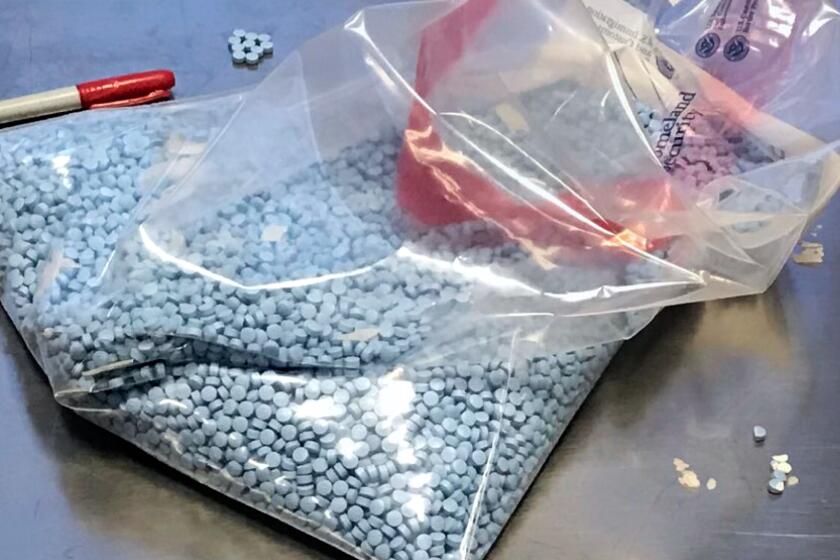Fentanyl deaths in L.A. County soared 1,280% between 2016 and 2021, report finds

The deadly toll from fentanyl comes as no surprise to Los Angeles County physicians and advocates who have been trying to save lives in hospitals and on the streets.
But that did not make the eye-popping figures laid out in a newly released report from the Los Angeles County Department of Public Health any less alarming: Deaths tied to illicit fentanyl have skyrocketed, with more than 13 times as many people losing their lives in 2021 as in 2016.
At a news conference Tuesday, county officials were joined by Juli Shamash, whose 19-year-old son Tyler died four years ago of an overdose involving fentanyl.
“Fentanyl is killing everyone and anyone,” Shamash told reporters. “To the parents out there that think, ‘Not my child,’ think again. This is killing straight-A students, track stars. All races. All religions. All socioeconomic groups.”
The findings underscore the threat of fentanyl, a synthetic opioid much more powerful than heroin that has been found mingled with methamphetamine and other illegal drugs and consumed unknowingly in counterfeit pills.
Across the country, roughly 70,000 people die annually from overdoses linked to synthetic opioids, a number that has more than doubled in three years, according to federal figures.
In L.A. County, the number of deaths linked to fentanyl rose from 109 in 2016 to 1,504 in 2021, amounting to a 1,280% increase, the Public Health Department found. Last year, fentanyl was involved in 55% of overdose deaths across the county, and among 12- to 17-year-olds who died of an overdose, the vast majority — 92% — tested positive for the drug.
In the last two months, agents with Homeland Security Investigations have seized as much fentanyl as they did in all of 2019, federal officials said.
Fentanyl is especially dangerous for people without a high tolerance for opioids, including teens, who have been dying of overdoses at increased rates in the U.S. even as drug use among the age group has fallen, UCLA researchers have found. In L.A. County, teen deaths involving fentanyl, although much rarer than those among adults, have multiplied in recent years, the new report found.
But the potency of fentanyl can also jeopardize longtime users of illegal drugs, said Dr. Gary Tsai, director of the Substance Abuse Prevention and Control division at the L.A. County Department of Public Health.
The massive rise in deaths “should be a serious concern for everyone,” Tsai said. “Everyone is potentially at risk.”
Emergency room visits and hospitalizations tied to fentanyl overdoses also surged in L.A. County in recent years, but not to the same degree as overdose deaths from the drug. This “suggests that a lot of people are dying before they have a chance to make it to the emergency room and then ultimately make it into the hospital,” Tsai said.
“We’re talking a matter of minutes where someone can ingest a pill and they can stop breathing. If someone doesn’t come across them and administer naloxone” — a medication that can reverse the effects of opioids — “they can very easily die before ever having a chance to make it to the hospital,” Tsai said.
County officials stressed that no group has been left untouched by the crisis but raised concerns about racial and income disparities that might be overlooked. More white residents than Black residents died of fentanyl overdoses in L.A. County last year, but Black people died at higher rates. Black people make up 8% of the L.A. County population but accounted for 17% of deaths from fentanyl overdoses, the report found.
USC professor of population and public health sciences Ricky Bluthenthal suggested in an interview that one reason might be racial inequities in access to naloxone, based on previous research in L.A. and San Francisco.
There were also many more deaths from fentanyl overdoses recorded last year in the richest areas of L.A. County than in the poorest ones, but fentanyl death rates were more than three times as high in the poorest parts, the report found.
Public health officials have stressed that there are tools to combat the threat. Fentanyl can be detected using testing strips to ensure that people do not take the drug unknowingly. Its deadly effects can be reversed with naloxone, widely known as a nasal spray under the brand name Narcan.
Opioid overdoses are “completely preventable if folks have access to naloxone,” said Jamie Baker, executive director of Being Alive L.A., a nonprofit focused on the needs of people with HIV and AIDS that runs syringe programs in Los Angeles and West Hollywood. “Any person — mom or dad or sister, aunt, uncle — could have nasal Narcan with them and in an instant be able to help somebody that’s in the middle of an overdose if they can recognize the signs and administer it. It’s so easy to do.”
But that happens only if someone is around to intervene, and people often use drugs alone because of stigma, said Chelsea Shover, an assistant professor at UCLA’s David Geffen School of Medicine.
“No one is going to be able to save you if you’re using alone,” she said, mentioning the Never Use Alone phone service as one resource.
Fentanyl deaths among teens more than doubled from 2019 to 2020, increasing from 253 to 680. Last year, the number jumped to 884, according to a report from the Journal of the American Medical Assn.
L.A. County has pushed to put tens of thousands of boxes of Narcan into the hands of people in vulnerable communities, equipping them to rescue others. L.A. public schools announced that they would start stocking Narcan this fall after a string of teen overdoses, and officials want L.A. County libraries to do so as well. Across California, community groups can get free naloxone through a state program, but booming demand has led to longer waits to get the lifesaving medication.
County officials also announced Tuesday that they are launching a working group to bring together leaders across local government to confront the crisis. The group will include representatives of the L.A. County district attorney’s office, Department of Public Health, Office of Education and the Los Angeles Police Department, among others.
Public Health Department Director Barbara Ferrer said experts from various fields will “share experiences and ideas so we develop a cohesive strategy that protects our communities.”
Dist. Atty. George Gascón said the group must also “look at what hasn’t worked in the past.”
“We recognize that a lot of the solutions that we applied in the ’90s were unsuccessful,” Gascón said. “Frankly, had they been successful, we would not be standing here today.”
Tsai said the county also plans to roll out a campaign to educate the public about the risks of fentanyl, expand naloxone access and ensure that more people can get medications to assist with addiction treatment.
“It’s still challenging, today, to get treatment. Not everyone is going to want treatment, but for people that do, we should make it very easy,” Shover said. For people who are using a combination of opioids and methamphetamine, effective treatment can be even harder to access, she added.
The report emphasized the ongoing need for “harm reduction” strategies that seek to reduce the effects of drug use, including expanding access to Narcan and fentanyl testing strips, as well as creating “safer consumption sites” where people could use drugs under supervision and get immediate help if they overdose.
Earlier this year, Gov. Gavin Newsom vetoed a state bill that would have allowed such sites to be launched through pilot programs in Los Angeles, San Francisco and Oakland, but advocates have vowed to keep pursuing the idea, which is underway in New York City and has been approved by lawmakers in Rhode Island.
Bluthenthal, the USC professor, argued that “we need consumption sites at this point if we want to make a dent in” the opioid problem.
Tsai said county officials had participated in “early discussions with the state” about the idea and that having a working group that includes law enforcement could be critical in moving forward with supervised sites.
“There’s no point in standing up a program only to have police or others intervene and say, ‘You can’t do this,’” Tsai said.
More to Read
Sign up for Essential California
The most important California stories and recommendations in your inbox every morning.
You may occasionally receive promotional content from the Los Angeles Times.














